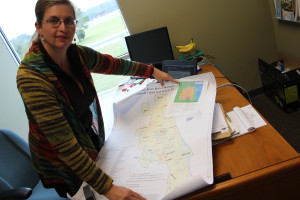
Green slime was dripping down their legs when they came out of the water that day. Lisa Rinaman and her two young boys were wading and bait fishing in Julington Creek on a beautiful spring day. Algae had apparently gotten an early start in the St. Johns River tributary, and since algae can make you sick, she wouldn’t let the boys back in the water.
“That’s heartbreaking, both as a mother and as a riverkeeper, to have to tell people to stay away from the river,” she said.
Rinaman is head of the St. Johns Riverkeeper, a non-profit, privately-funded watchdog group that monitors and advocates for the river. That day with her boys was just the beginning of what would make 2013 an especially bad year for algae blooms in the lower basin of this north-flowing river.
That summer there were reports of people water skiing with a green wake behind them, Rinaman said. A Naval training exercise that was supposed to take place in the river had to be moved offshore. And during Columbus Day weekend, Doctor’s Lake Marina in Orange Park refused to rent jet skis or inner tubes because they were concerned about their customers’ safety.
“Marinas are usually small businesses, and that really hurts, so there’s the economic impact as well as the health impact,” Rinaman said.
Fertilizer runoff, livestock runoff, leaky septic tanks, and commercial discharge enter the river at many points on its 300 mile trek north from the Vero Beach area. All that junk becomes concentrated near the mouth in North Florida, and when temperatures heat up in the summer months, blooms can occur.
“Algae blooms are a symptom of the pollution that’s already in the river,” said Rinaman.
For the past 10 years, algae blooms have always occurred during the summer, but lately they’re starting earlier and lasting longer. “We’ve already had two reports in 2014, so we think it didn’t die off like it has in the past,” she said.
Rinaman has been in her watchdog role for two years over a river the EPA named one of 14 American Heritage Rivers due to its economic, historic, and environmental importance. In 2008, the environmental group American Rivers named the St. Johns River one of the country’s “Most Endangered Rivers,” citing concerns about “massive water withdrawals” being proposed to meet water needs for Florida’s high growth rate.
Yet water withdrawal plans have continued, while at the same time, spring flows are down. There are two plans currently up for public comment from water management districts that would allow about 265 million gallons per day to be withdrawn.
The river is fed by 85 freshwater springs, mostly located in Central Florida, which have seen reduced flows from a combination of over-pumping the state’s underground water supply, and a prolonged drought. Because the river winds across an area with flat elevation, it flows slowly and has trouble flushing out pollutants, like the ones that cause algae blooms. Reduced spring flow just makes the problem worse.
In addition, there is a proposal from JaxPort, the Jacksonville port authority, to dredge the mouth of the river from 40 feet to 47 feet deep to accommodate the huge new container ships that will come through the deepened Panama Canal. Scientists warn dredging will cause increased salinity from the Atlantic Ocean, which will change the ecology of the northern end of the river.
From one end to the other, it seems everyone wants a piece of the St. Johns River. Lisa Rinaman has her work cut out for her.
Having worked for two mayoral administrations, the 44-year-old Rinaman has plenty of experience managing competing interests. “One of her great strengths is consensus building,” said longtime colleague Maria Hane, executive director of the Museum of Science and History, who once hired Rinaman. “Lisa brings a balanced perspective – as a stakeholder, policy maker, and environmental advocate.”
Even Rinaman’s opponent on the dredging issue, Nancy Rubin, Sr. director of communications for JaxPort, has praise for her. “You are so lucky to have her,” Rubin told the audience at a public meeting about the proposed dredging. Rubin called talks with Rinaman “fruitful and respectful.”
Rinaman is the third riverkeeper in the 10-year-old organization, a concept first started in New York’s Hudson River Valley and made famous by Robert Kennedy, Jr.’s advocacy. Today SJRK is one of 200 waterkeeper organizations on six continents, according to the Waterkeeper Alliance, whose members serve as “part scientist, teacher and law officer.”
SJRK is headquartered in Jacksonville because “that’s where all the environmental damage shows up,” said Rinaman. But she hopes to extend her outreach up river into Central Florida. “It’s all connected,” she said. “The river is only as healthy as our springs.”
Like many Floridians, Rinaman moved to Florida because she “fell in love” its rivers, beaches, and preserves. “I’m a beach girl,” said the Arkansas native, whose first date with her husband was a moonlit kayaking trip on the St. Johns.
Her message to Floridians is one that seems to fit her reputation for consensus building: rather than compete for the resources of the St. Johns River, she wants citizens to “make sure we speak with one voice and make sure decisions are long term to protect all of Florida’s waters – because that’s what makes Florida magic.”


Leave a Reply